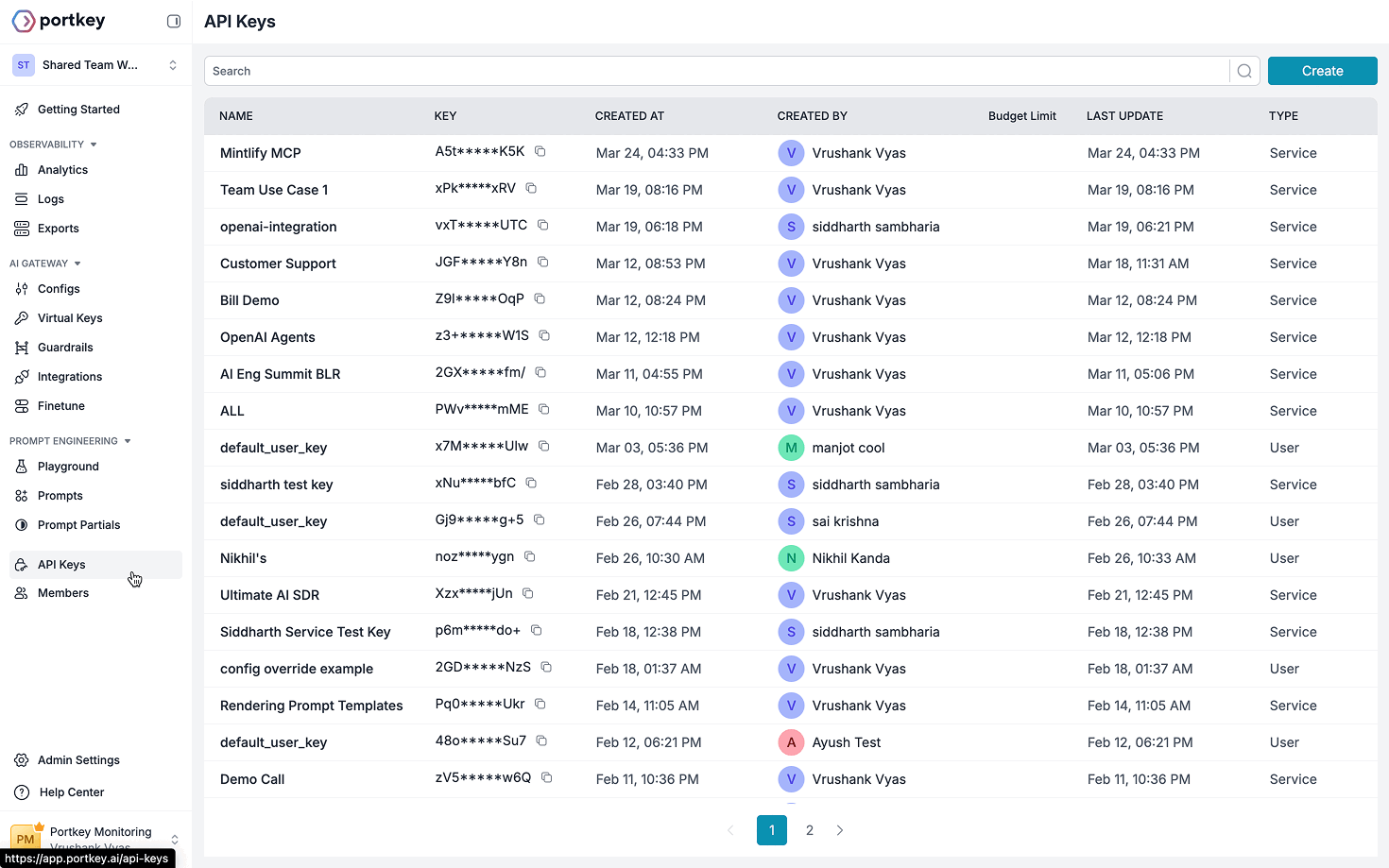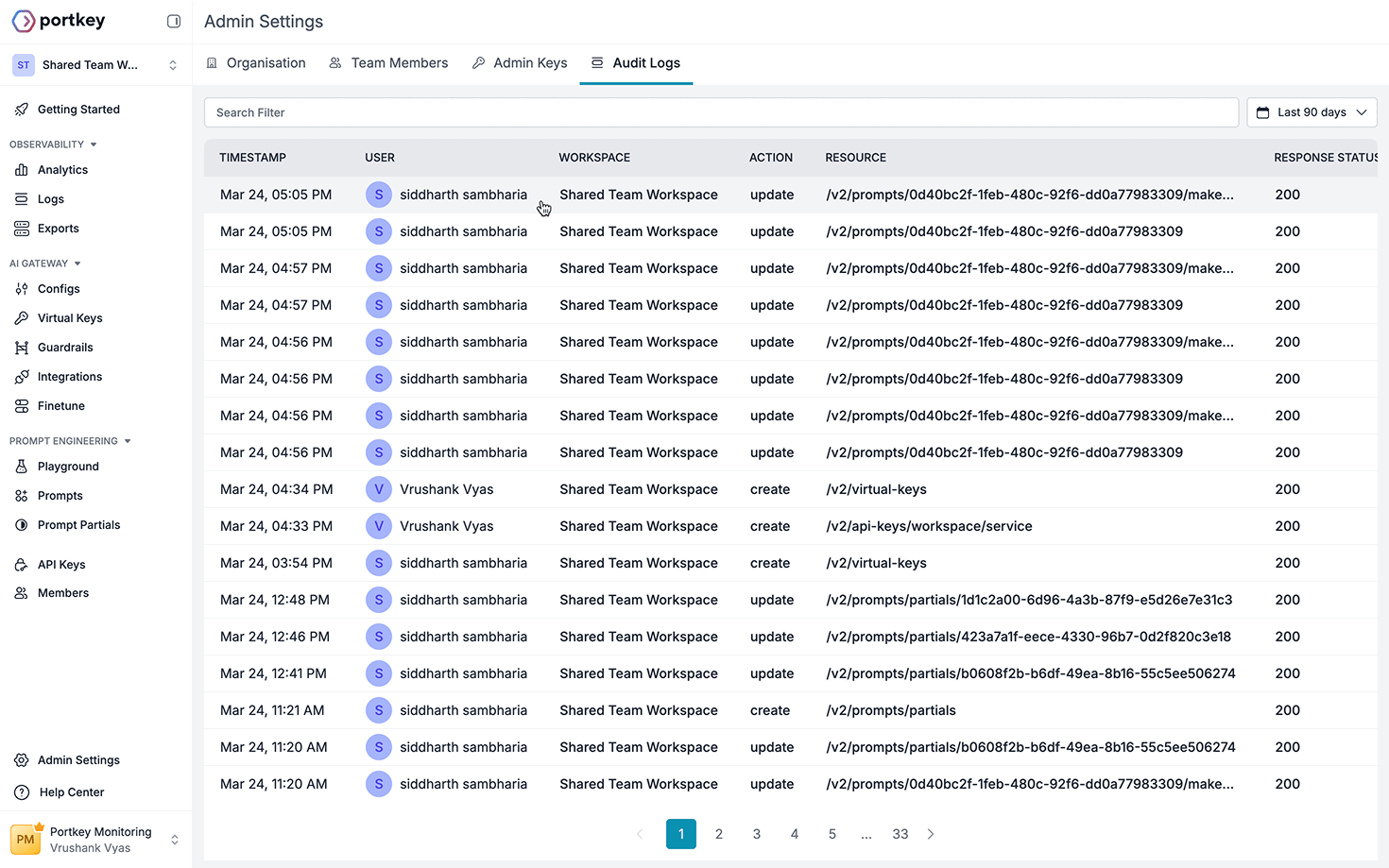Portkey Admin API
The Portkey Admin API provides programmatic access to manage your organization, workspaces, and resources. Whether you’re automating routine administration tasks, integrating Portkey with your existing systems, or customizing your deployment at scale, this API gives you the tools to control every aspect of your Portkey implementation.Understanding the Admin API Ecosystem
The Admin API is organized around key capabilities that let you manage different aspects of your Portkey environment. Let’s explore what you can build and automate:Resource Management
At the foundation of Portkey are the resources that define how your AI implementation works. These can all be managed programmatically:Configs
Create and manage configuration profiles that define routing rules, model settings, and more.
Virtual Keys
Manage virtual API keys that provide customized access to specific configurations.
API Keys
Create and manage API keys for accessing Portkey services.
Analytics and Monitoring
Once your resources are configured, you’ll want to measure performance and usage. The Admin API gives you powerful tools to access analytics data:Summary Data
Retrieve aggregated usage statistics and performance metrics.
Grouped Data
Access detailed analytics organized by metadata, model, or user.
Time Series Data
Monitor performance trends, costs, errors, feedback, and usage patterns over time.
User and Workspace Administration
Beyond resources and analytics, you’ll need to manage who has access to your Portkey environment:Users & Invites
Manage user accounts, permissions, and access. Send and manage user invitations.
Workspaces & Members
Create workspaces and manage team membership and permissions within workspaces.
Authentication Strategy
Now that you understand what the Admin API can do, let’s explore how to authenticate your requests. Portkey uses a sophisticated access control system with two types of API keys, each designed for different use cases:Admin API Key
Organization-wide accessThese keys grant access to administrative operations across your entire organization.
Only Organization Owners and Admins can create and manage Admin API keys.
Workspace API Key
Workspace-specific accessThese keys provide targeted access to resources within a single workspace.
Workspace Managers can create and manage Workspace API keys.
Access Control and Permissions Model
Portkey’s hierarchical access control system governs who can use which APIs. Let’s examine how roles, API keys, and permissions interact: This access model follows a clear hierarchy:| Role | Can Create Admin API Key | Can Create Workspace API Key | Access Scope |
|---|---|---|---|
| Organization Owner | ✅ | ✅ (any workspace) | All organization resources |
| Organization Admin | ✅ | ✅ (any workspace) | All organization resources |
| Workspace Manager | ❌ | ✅ (managed workspace only) | Single workspace resources |
| Workspace Member | ❌ | ❌ | Limited workspace access |
Creating and Managing API Keys
Now that you understand the permission model, let’s look at how to create the API keys you’ll need:Through the Portkey Dashboard
The simplest way to create an API key is through the Portkey dashboard:
Creating an Admin API Key in the Portkey Dashboard
Through the API
You can also create keys programmatically:Understanding API Key Capabilities
Both key types have different capabilities. This table clarifies which operations each key type can perform:| Operation | Admin API Key | Workspace API Key |
|---|---|---|
| Manage organization settings | ✅ | ❌ |
| Create/manage workspaces | ✅ | ❌ |
| Manage users and permissions | ✅ | ❌ |
| Create/manage configs | ✅ (All workspaces) | ✅ (Single workspace) |
| Create/manage virtual keys | ✅ (All workspaces) | ✅ (Single workspace) |
| Access Analytics | ✅ (All workspaces) | ✅ (Single workspace) |
| Create/update feedback | ❌ | ✅ |
Security and Compliance: Audit Logs
For security-conscious organizations, Portkey provides comprehensive audit logging of all Admin API operations. These logs give you complete visibility into administrative actions:
Audit Logs in the Portkey Dashboard
- User identity
- Action type and target resource
- Timestamp
- IP address
- Request details
Audit Logs Documentation
Learn more about Portkey’s audit logging capabilities
Getting Started with the Admin API
Now that you understand the Admin API ecosystem, authentication, and permissions model, you’re ready to start making requests. Here’s what you’ll need:- Appropriate role: Ensure you have the right permissions (Org Owner/Admin for Admin API, Workspace Manager for Workspace API)
- API key: Generate the appropriate key from the Portkey dashboard
- Make your first request: Use your key in the request header
OpenAPI Specification
Download the OpenAPI spec for the Admin API
Need Support?
If you need help setting up or using the Admin API, our team is ready to assist:Book a Support Call
Schedule time with our team to get personalized help with the Admin API

